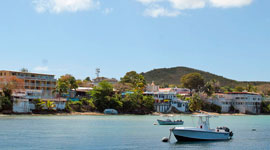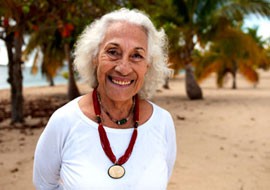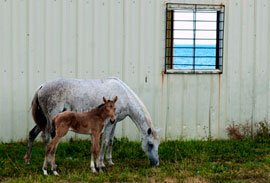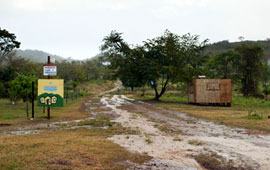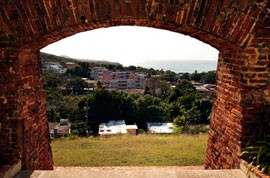Cronkite News has moved to a new home at cronkitenews.azpbs.org. Use this site to search archives from 2011 to May 2015. You can search the new site for current stories.
Puerto Rico: Rebuffed by federal agencies and courts, Vieques Island’s residents fight for their land and health
VIEQUES ISLAND, Puerto Rico — On this idyllic island off the northeast coast of Puerto Rico, all seems tranquil — but it hasn’t been for decades.
While Vieques is gradually being converted to a tourist hot-spot, more than 7,000 of its residents — American citizens by birthright — are suing the U.S. government for terrible ailments they say resulted from the Navy using their island as a bombing range for more than 40 years.
The U.S. Navy came to Vieques in 1941 and left in 2004. For a majority of that time, the eastern portion of the island was used for testing weapons, including a variety of munitions and toxic substances typically used in chemical warfare. Protests that drew international attention eventually led to the decommissioning of the Navy’s base in 2003, but its impact on the island lingers. Unexploded ordnance litters parts of the island and a higher than normal incidence of cancer stalks its residents.
“I have seen it affect my family seriously,” said Myrna Pagan, a longtime island resident and activist who was a key organizer in the protests. Pagan, a striking woman of 77, moved to Vieques with her husband in 1971. Her husband, Charlie Connelly, is now battling cancer. Pagan had cancer in 2001 and an unusually high number of her family members suffer from other chronic illnesses.
“I have nine grandchildren and all of them have respiratory problems. The doctors have no idea why,” said Pagan. “Was it because my daughter grew up here while all the bombing was going on? Maybe.”
In 1999 a stray bomb killed a Puerto Rican civilian guard, sparking outcries that eventually led to the base’s decommissioning. Protests got the Navy out but serious health issues remain.
Vieques residents are 27 percent more likely to develop cancer than residents of the main island, according to a Puerto Rican Health Department report from 1999. The same report also said Vieques residents had a 381percent higher rate of hypertension and 41percent higher rate of diabetes.
“There is not a family that has not been struck,” said Pagan. “That’s the way it was. I think it’s a conservative figure to say that we are 27 percent higher in cancer than the rest of Puerto Rico.”
Vieques’ tropical beaches and quiet island lifestyle is a stark contrast to its military history. The island still is mostly undeveloped and wild horses saunter freely through some streets. The island’s per capita income is about $6,500, according to the 2000 Census. The only way to get to and from the island is by ferry, which was overcrowded this spring with vacationers making the eight-mile trip from the main island.
Navy Claims ‘Sovereign Immunity,’ Lawsuit Dismissed
A class action lawsuit was filed against the Navy by three-fourths of the island’s residents in 2005. It seeks monetary reparations for health problems the plaintiffs believe were caused by toxins left over from weapons testing. The lawsuit asserts the Navy failed to warn residents of any potential danger from the government’s military activities.
The case, however, was dismissed in 2010 by a federal district court in Puerto Rico. That dismissal was affirmed on a 2-to-1 vote of a three-judge panel of the U.S. First Circuit Court of Appeals on Valentine’s Day 2012. Both courts said the Navy had “sovereign immunity,” a legal doctrine that gives the federal government broad “discretion” to carry out its activities without being sued, except under a few circumstances specified by Congress. The court declined to judge the case on its merits.
“The problem here is that the Navy was acting within its discretion when it was bombing the island,” said John Arthur Eaves Jr., a prominent Mississippi attorney representing the Vieques residents. “Yes, the Navy was doing what it was designed to do. But it violated the law, which is not within their discretion.”
Eaves is referring to violations of the Clean Water Act of 1972. The Environmental Protection Agency cited the Navy for violating the act by dropping too many bombs off the shores of Vieques. In one year alone, the EPA cited the Navy 102 times, according to Eaves. This evidence was never presented to the court, however, because the court agreed with the Navy’s argument that it had discretion to use the island as a bombing range. Any harm caused by these actions, said Eaves, is collateral damage under the doctrine of sovereign immunity.
The dissenting appellate judge in the case, Juan Torruella of Puerto Rico, wrote that the government shouldn’t have been shielded by sovereign immunity because it knew how toxic the bombings were but chose not to warn Vieques residents.
“Nowhere does the medieval concept of ‘the King can do no wrong’ underlying the doctrine of sovereign immunity sound more hollow and abusive than when an imperial power applies it to a group of helpless subjects. This cannot be a proper role for the United States of America,” Torruella wrote.
All three judges agreed that the lawsuit raised legitimate and serious concerns about health on the island and suggested that Congress was proper venue for redress.
Supporters of the Vieques residents have already turned to Congress as well as the courts.
“The Vieques Recovery and Development Act of 2011,” which would provide funding for a hospital and toxins research center for the island, was introduced by New Jersey Rep. Steve Rothman and Puerto Rico’s non-voting representative, resident commissioner Pedro Pierluisi.
“The federal government was responsible for the military activities there, the least they should be doing is coming up with a plan so that all the agencies involved would do whatever testing needs to be done at the federal government’s expense, ” said Pierluisi. “It’s the least they owe to the people of Vieques.”
Providing locals with proper medical care is a crucial issue that so far has been met by inaction. The island’s 9,300 residents have no hospital and only a clinic with no cancer treatment available. Those needing cancer treatment take the 45-75 minute journey on the ferry, then travel two hours to San Juan to see oncologists.
“If we had a real hospital people would just go to the hospital and you would have some preventive treatment,” said Pagan. “The abominable ferry service and the number of people that go over to the big island for medical treatment are all things that can be done here if the center were adequate.”
80 Million Pounds of Chemical Weapons
The amount of potential toxins on Vieques is sobering. More than 80 million pounds of chemical weapons, bombs and ammunition were dropped on the eastern portion of the island for a good part of the 20th century. Its soil still harbors bullets filled with radioactive depleted uranium and unexploded bombs.
“We couldn’t find out exactly what had been used out there,” remembers Pagan. “Then finding out that the U.S. government had allowed depleted uranium on this island… it was really, really shocking.” The Navy began cleaning up the island in 2005 when Vieques was added to the Superfund National Priorities List — a list of hazardous waste sites requiring clean up.
Dan Waddill, head of the Navy’s Vieques restoration program, said there are more than 100 people working five days a week to remove surface debris and ordnance on Vieques, under EPA oversight.
“Much of what we do is making sure we are protective of endangered species. We look at, ultimately, when we are done if the site is safe from an ecological point of view, as well as the human health point of view,” said Waddill.
In addition to munitions that have been removed, Waddill reported that 17 million pounds of scrap metal and debris has been taken from roughly 1,800 of the 25,000 acres previously used for Navy training and bombing. According to Waddill, they still find bombs almost every day, although he said the worst has been cleaned up.
When a live bomb is found, typical procedure is often to detonate it on the spot. Ismael Guadalupe, a Vieques native and another longtime activist, feels the current clean up strategy isn’t the best possible method.
“When they are cleaning, they destroy the bomb in the place they found it, and what happens with the toxins? They are still here. It’s like sweeping the dust under the rug,” said Guadalupe.
Waddill, however, says they are using the best solutions they can for Vieques.
“We do a lot of testing to ensure that exploding the bombs do not create problems,” said Waddill. “We do find elevated levels of some contaminants including metals and right now we are in the process of working with regulators to figure out what we will do.”
Because of the clean up, much of the island is still owned by the U.S. Department of the Interior, a fact that has been a point of tension for the Vieques community. The lack of local control over lands was an issue when the Navy still occupied the island and continues to be one of the residual issues since its departure.
“Fish and Wildlife still has control and owns an incredible amount of land in Vieques,” said Pierluisi. “Perhaps we should consider additional transfers to the municipality of Vieques for its additional development.”
Guadalupe, 67, was born on the island and is a retired high school theater teacher. He has been witness to the complex relationship between the Navy and the community on the island.
“We found out about the uranium bullets, then later, that we had a higher rate of cancer,” said Guadalupe, whose wife is a cancer survivor. “Then, we were not fighting for the problems of the bombing or the problems with the soldiers or our land. We were demanding our health. My people were dying on Vieques.”
While clean up has been ongoing since 2005, the question of the military’s connection to Vieques’ health epidemic has, at least officially, gone unanswered. Talk to Vieques residents or supporters however, and they say the answer is obvious.
“There is ordnance all over that island still. You don’t need to be a scientist or doctor to realize that okay probably that has something to do with the shelling with all these military exercises that happened there for more than 40 years,” said Pierluisi.
Government Agency Finds No Proof of Health Risk
The Agency for Toxic Substances and Disease Registry (ATSDR) contends there is no definitive connection between the Navy’s weapons testing and the islanders’ numerous and heightened health problems.
The ATSDR is a federal agency created to prevent harmful exposures and diseases related to toxic substances. They have released eight reports on Vieques since 1999 when they were asked by a local resident to look at a possible link between the Navy’s contaminants and emerging health issues.
“There are definitely some vocal people on Vieques and of course the problem is that there are sick people on Vieques,” said ATSDR’s Vieques site team leader, Lisa Hayes. “There is negative feed back and they feel like we are missing something.”
Myrna Pagan is one of those vocal residents.
“I am a victim of cancer and my husband too. And so many of my friends, and I am thoroughly convinced that it was as a result of the bombing. How can you say there is no link to that amount of toxins coming into this small of a populated island and the illness because of contamination?” asked Pagan. “The ATSDR argument is that there is no link, which is absolutely bizarre and grotesque to say.”
Dr. Cruz Maria Nazario, an epidemiologist and professor at the University of Puerto Rico, has studied and critiqued ATSDR’s conclusions since it began its reports on Vieques in 1999. She says that the methodology used in the ATSDR reports is flawed.
“They design their studies so that they reach no conclusion. I think the ATSDR is there to protect the industry and the Navy is the most important industry in the United States,” said Nazario. “The ATSDR, instead of protecting the health of Americans, is protecting the interests of the Navy.”
The ATSDR began working on its most recent report when members of Congress questioned the conclusions from their 2009 report. The new study essentially confirmed former findings.
“Our science doesn’t show us a link between the bombing range and how the people could have been exposed to the contaminants,” said Hayes. “We believe we have done a very good job of evaluating the data that is out there and coming up with the appropriate conclusions.”
Resident commissioner Pierluisi is among those in Congress who feel the ATSDR hasn’t adequately addressed Vieques residents’ concerns.
“All the activities ended in 2003, roughly nine years ago and by now its amazing ATSDR is still saying, ‘the data is not good enough, we need to study this more’,” said Pierluisi. “To me, that’s scandalous. It’s not acceptable.”
Vieques Saga Only in ‘First Act’
Nazario has ceased her critiques of ATSDR since the 2009 report. She says it’s not about finding the cause of Vieques residents’ higher rates of cancer anymore. Now, it’s about getting them treatment. “They have cancer and they will continue to have cancer,” said Nazario.”If they get early diagnosis and good treatment, there is no need for people to die of cancer.”
The ATSDR reports also have slowed Vieques residents’ quest for redress but the battles continue in court, Congress and on the island.
“People used to have no voice but now people are wondering, ‘why are my kids sick? What is going on?’” said Nazario. “We have to make people aware that Viequenses are Americans and they gave the best of their life and their children. Now they’re getting sick and they need help.”
Eaves said he plans to appeal the Vieques case in hopes of reaching the U.S. Supreme Court but is also turning his hopes toward the Vieques bill in Congress. He knows that money is not necessarily what will heal the harm done to the people and the land.
“The problem with the law is that money is all you can ask for,” said Eaves. “If you compensate without some assistance and coordination of that assistance, monetary assistance will not achieve a permanent solution for Vieques.”
Guadalupe, who has been fighting for his island for nearly 50 years, believes the fight for Vieques is far from over. Ironically, he and Pagan, another longtime activist, are not part of the lawsuit.
“I am not opposed to the lawsuit but I do not want their money. I want to recover the struggle. We still have the same problems. The Navy still has our land, and we have problems with health,” said Guadalupe. “I told you I was a drama teacher, and I believe we are only in the first act.”






